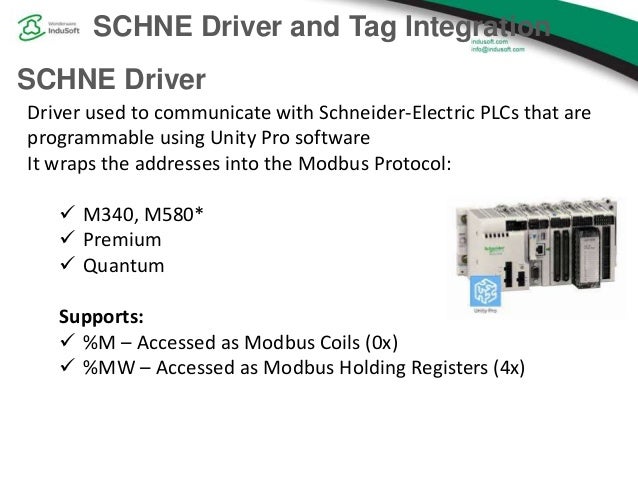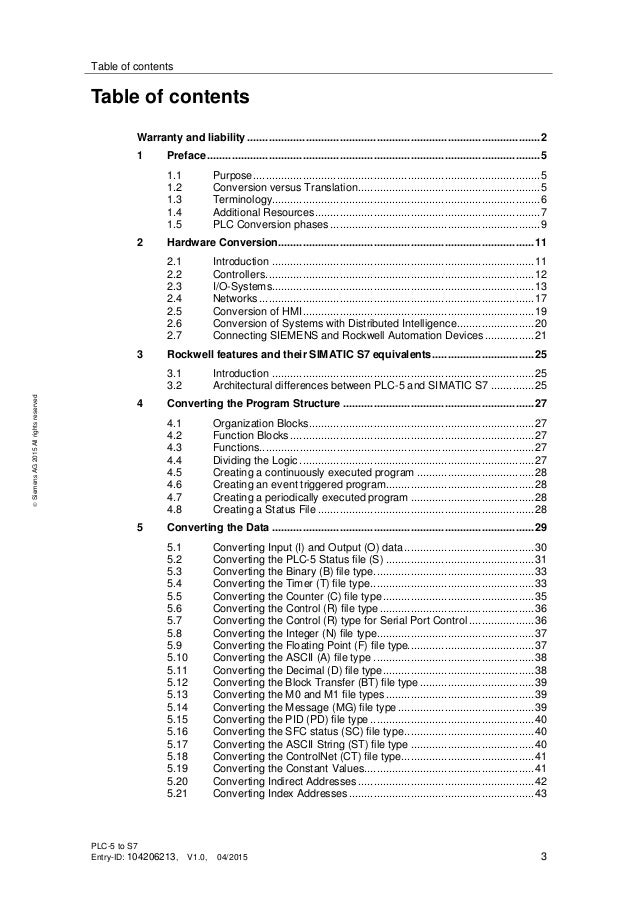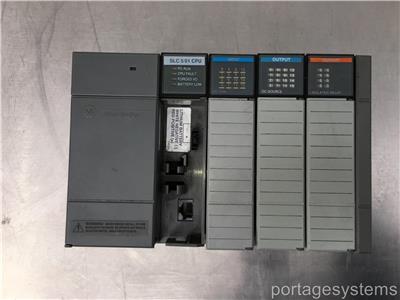Plc 5 1/2 Slot Addressing
Study PLC'S Chapters 1&2 flashcards from Anna Cormier's Lamar Institute of Technology class online, or in Brainscape's iPhone or Android app. Learn faster with spaced repetition. . Basic AB PLC addressing X1:x.0/0 Data file type I – input O – output S – status B – binary T- timer C-counter Data file number (can be omitted for the basic data files) Slot number (not used with the simulator) Word number: selects a specific word in a data file Bit number I/O located on the controller (embedded I/O) is slot 0.
Before you can program any PLC system, you have to understand how the addressing is done in that particular PLC. I have included a actual screenshot from RSLogix 5000 below that shows examples of addressing in RSLogix 5000.

INSTRUCTION – RSLogix 5000’s Relay Ladder Logic command language is comprised of “instructions”. An XIC (it looks like a normally open contact –] [– ) is an instruction. A timer is an instruction. A few of the most common instructions are described below.
BIT – an address within the PLC. It can be an input, output or internal coil, among others.
RUNG – A section of the PLC ladder program that terminates in an output function of some type. Just like in an electrical ladder diagram, a rung has some type of output that is turned on or turned off by the preceding entities in the rung. The first rung in a ladder program is always 0.
HARDWIRED INPUT – a physical connection to the PLC from an input device (switch or sensor, etc.).
RSLogix 5000 defines the address of the input, based on the input cards that you configure.
We’ll see how this works later on, but here is an example of a hardwired input:
Local:4:I.Data.3
Here is what each part of the address means:
Local:4:I.Data.3
“Local” means that the module is connected to a controller across a backplane or with a parallel link, keeping the module within a few inches of the controller.
Local:4:I.Data.3
“4” means that the module is module 4 (located in the 5th slot in the rack).
Local:4:I.Data.3
“I” means the bit is an input
Local:4:I.Data.3
“Data” indicates the type of data (this is the default for I/O)
Local:4:I.Data.3
“3” indicates that the bit is 4th input on the card (the bits start with 0).
By the way, don’t get the capital “I’s” confused with ones.
So, in evaluating our example, we would describe the bit as “Module 4, bit 3”.
Here is where some confusion comes in. Because the Rockwell numbering system starts with 0, and the processor resides in Slot 0, our example bit is actually in slot 5. Our bit 3 is actually the 4th bit. We could also describe the bit as “Slot 5, position 4”.
You will have to learn to transpose these ways of describing a bit back and forth in your head. If you are troubleshooting a problem, and you want someone to look for a signal on our example bit, you might have to tell him to look at the 4th position on the 5th slot. That will lead him to the physical point on the PLC.
However, you need to keep in mind that the corresponding bit in your program will be labeled Local:4:I.Data.3.
It can be confusing, but you will get used to it.
HARDWIRED OUTPUT – a physical connection from the PLC to an output device (relay or pilot light, etc.)
Outputs are addressed the same way.
Local:5:O.Data.4
“Local” means that the module is connected to a controller across a backplane or with a parallel link, keeping the module within a few inches of the controller.
Local:5:O.Data.4
“5” means that the module is module 5 (located in the 6th slot in the rack).
Local:5:O.Data.4
“O” means the bit is an output
Local:5:O.Data.4
“Data” indicates the type of data (this is the default for I/O)
Local:5:O.Data.4
“4” indicates that the bit is 5th output on the card (the bits start with 0).
INTERNAL COIL
This is a programmable bit used to simulate a relay within the PLC. The internal coil has no connection to the outside world. It does not connect to an output card. Internal coils are used to store information. The “contacts” of this “relay” can then be used multiple times in other parts of the program.
RSLogix 5000 has greatly simplified the process of describing an internal coil. We can simply give it a name, known as a tag.
For example, if you have an internal coil that is the result of, say, three hardwired safety gate limit switches, we could label the coil “SafetyGatesClosed”.
Note the lack of spaces in the tag name. RSLogix 5000 does not allow spaces, or other special characters, in the tag name.
Some people use underscores, so the tag might be “Safety_Gates_Closed”. Either way is fine; it just depends on what your company or your client prefers.
TIMER
A timer is a programmable instruction that lets you turn on or turn off bits after a preset time.
The two primary types of timers are TON for “timer on delay” and TOF for “timer off delay”.
Timers in RSLogix 5000 use tag names for identification.
COUNTER
A counter is a programmable instruction that lets you turn on or turn off bits after a preset count has been reached.
There are different types of counters available in the RSLogix, but the CTU (counter up) instruction covers everything we will talk about here.
Counters in RSLogix 5000 use tag names for identification.
–] [– Normally Open Contact
When used with a hardwired input, this instruction is off until there is a voltage applied to the input. The bit address then goes high, or on, and the instruction becomes “true.” It works the same way when it has the same address as an internal coil, except that the coil must be turned on by logic in the program.
Allen-Bradley calls these normally open contacts “XIC”, or “eXamine If Closed” instruction.
An XIC instruction can reference a hardwired input, a hardwired output, an internal coil or a timer done bit, among others.
–]/[– Normally Closed Contact
This is an inverted normally open contact.
When used with a hardwired input, this instruction is “true” until there is a voltage applied to the input. It then goes low, or off, and becomes “false.”
It also can be used with an internal coil, becoming true when the coil is off and becoming false when the coil is on.
Allen-Bradley calls these normally closed contacts “XIO”, or “eXamine If Open” instructions.
-( )- Output Coil
When used with a hardwired output, this function is off until the logic in the program allows it to turn on. It then becomes “true”, and will energize the device that is wired to the respective output.

If it is used as an internal coil, it will toggle the instructions associated with it. That is, it will close a normally open instruction and open a normally closed instruction.
Allen-Bradley calls these outputs “OTE”, or “OutpuT Energize”.

An OTE may be used with a hardwired output or an internal coil.
TRUE – A state that indicates an instruction is allowing logic to “flow” through it.
Also, if the logic in a rung turns on the output of the rung, then the rung is said to be true.
FALSE – Without stating the obvious, this is the opposite of true.
Excerpted from PLC Programming with RSLogix 5000
Micro/SLC-500/PLC 5 Addressing Formats
Plc 5 1/2 Slot Addressing System
The general format of value names for data from the listed controllers matches the naming convention used by the programming software. The format is shown below. The parts of the name shown in in square brackets [] are optional.
General Value Name Format: X: [file] element [.field] [/bit]
Plc 5 1/2 Slot Addressing Tool
X is the file type. The following table lists valid file types, the default file number for each type, and fields allowed:
Plc 5 1/2 Slot Addressing Machine
| X | File Type | Default File Number | Fields |
| O | Output | 0 | |
| I | Input | 1 | |
| S | Status | 2 | |
| B | Binary | 3 | |
| T | Timer | 4 | .PRE, .ACC, .EN, .TT, .DN |
| C | Counter | 5 | .PRE, .ACC, .CU, .CD, .DN, .OV, .UN, .UA |
| R | Control | 6 | .LEN, .POS, .EN, .DN, .ER, .UL, .IN, .FD |
| N | Integer | 7 | |
| F | Floating | 8 | |
| A | ASCII | None |